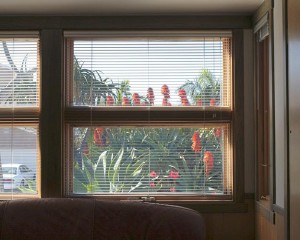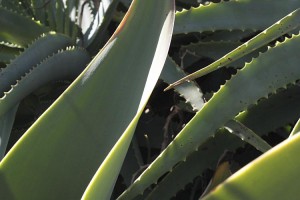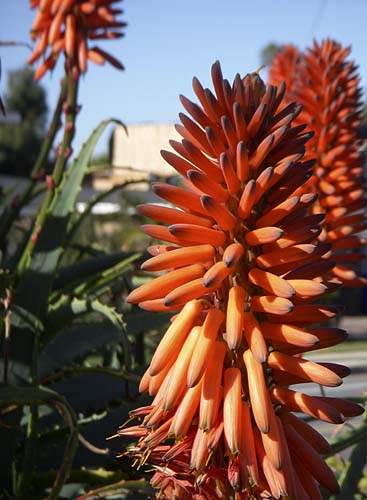
I’m heartbroken that one of the two big tree aloe in the front yard is under attack by aloe mites, the scourge of many aloe growers. The succulent expert at one of my local nurseries just shook his head when I asked for anything that would make the mites go away. Of course I ran to the web for advice. Discussions splattered all over the charts, from guardedly optimistic to “throw the thing in the trash.” I started to uncover several references to the syndrome that the aloe gall mites generate as “aloe cancer.”
The best discussion I encountered I’ve seen so far is at XericWorld forums, where the whole range of opinions gets expressed by a number of experts. The thread has lots of photos of infected plants and of the mites themselves. Growers expressed success with insecticides (even though mites aren’t insects). Others had zero results even with dedicated miticides. Most people recommend plant-surgery, and one person treated affected areas with bleach.


Sunbird Aloes, a commercial firm in South Africa, the land of aloes, recommends a completely different treatment: formaldehyde applied to the gall.
There’s also an informative page hosted by Michael J. Green hosted at the Gates Cactus & Succulent Society [ here ]. The author here points out that the gall is produced by the plant in reaction to a chemical produced by the mites, a compound similar to 2-4-d, one of the main ingredients in the infamous Vietnam War herbicide Agent Orange.

Most of the treatments are intended for spot treatments when only part of the plant is infested. But my poor plant has a major infestation all over its main trunk, and that’s been affecting the growths farther up. It’s been in gradual decline for several years, but it’s going downhill quickly. At first I thought it was gophers eating the roots, or the renters next door stopping watering of their lawn and the aloe roots that extend under it. But I’ve finally figured out the awful truth. Even the plant seems to realize its distress since it’s starting to shoot new growths from near the base of the trunk.
I step back and try to be philosophical and maybe even marvel in my grief that such tiny, nearly microsopic creatures can take down such a large plant. It’s all a part of the cycle of life that we celebrate with the seasons and the changes plants go through. Only with something tree-sized I was hoping for something that would outlive me, not a twenty-year relationship that would end in tragedy.

If any of you have had luck with something let me know! In the meantime I’m trying a few treatments. As much as I try to avoid chemical nastiness in the garden, I’m desperate. I’m removing the galls and swabbing the infected area with a 50% bleach solution. I’ve applied the systemic insecticide imidacloprid at the roots, hoping that the insecticide won’t affect the beneficial bugs feeding on the plants nearby. Then I tried to spray just the affected plant–a big 12-16 footer–as best as I could with Bayer 3-in-1, which in addition to imidacloprid contains the miticide tau-fluvalinate. I don’t know that these treatments will do anything other than relieve me of guilt that I didn’t try what I could to save the plant.
Wish me luck.

























